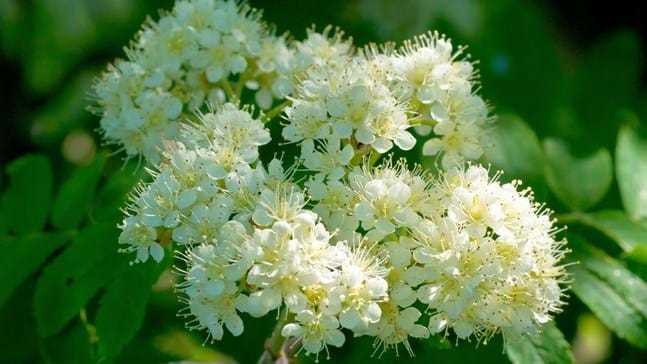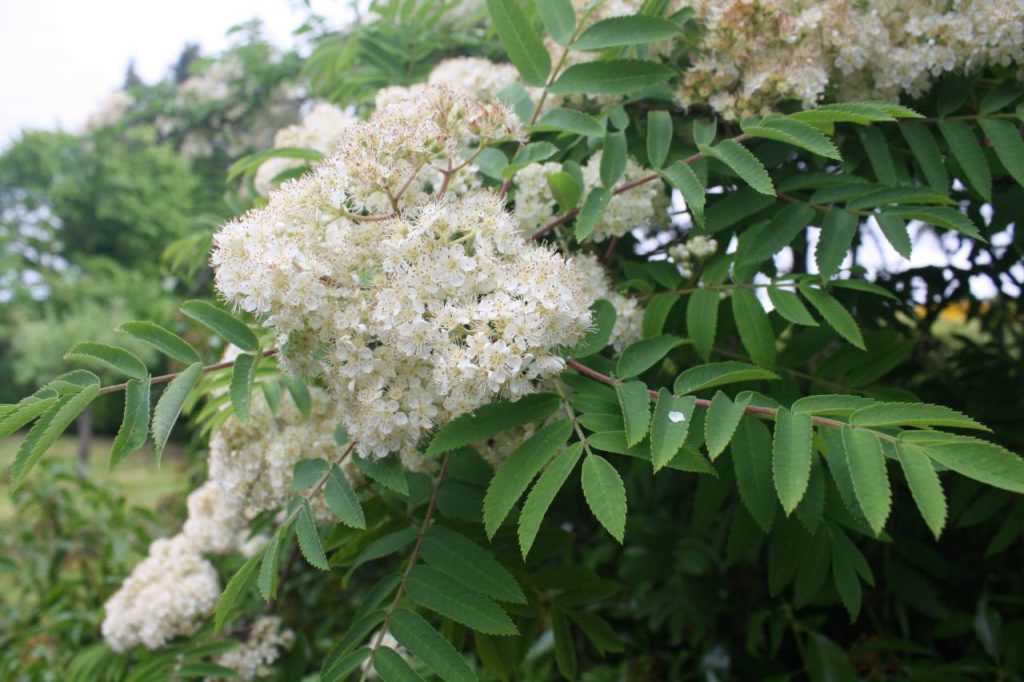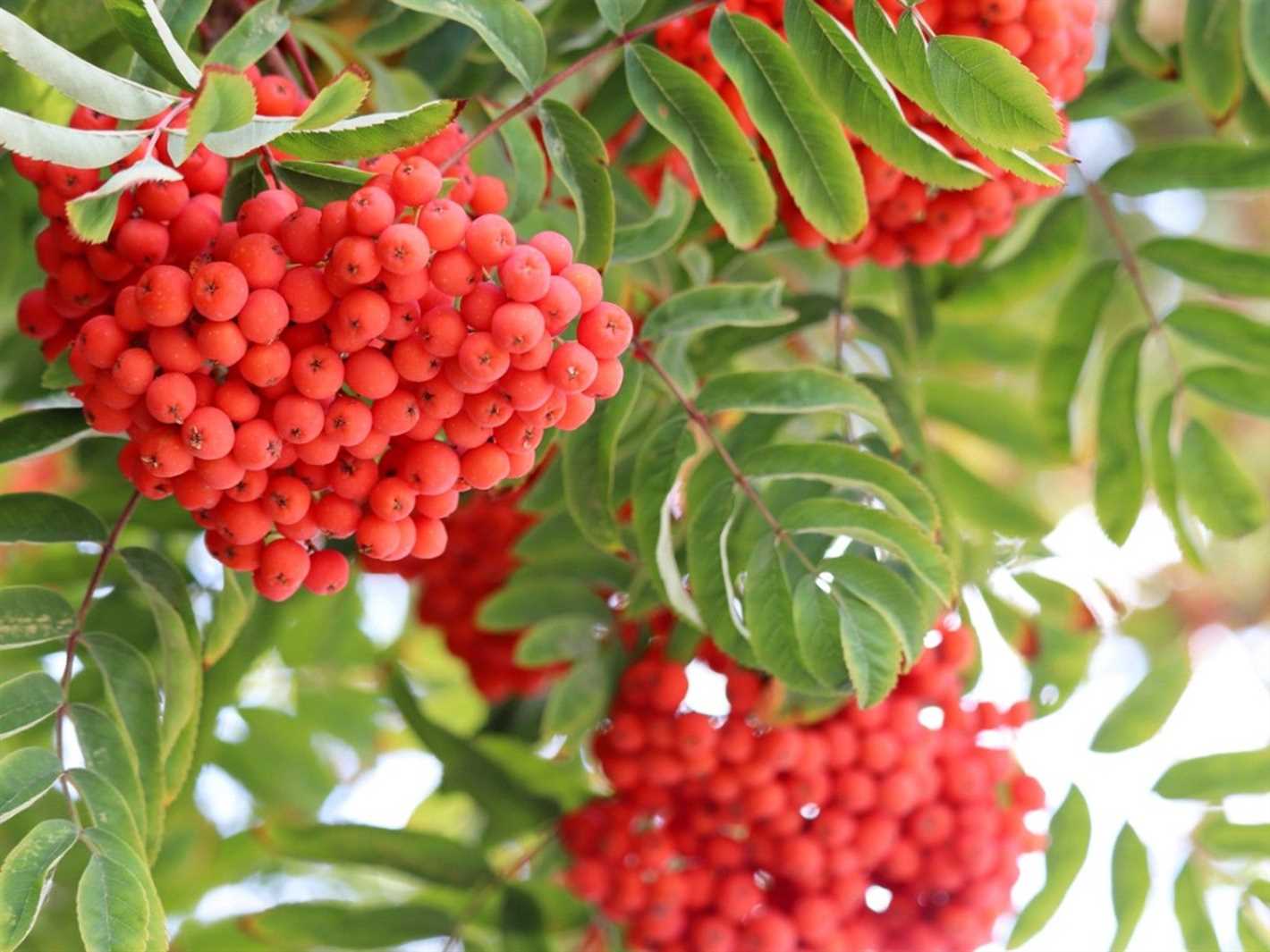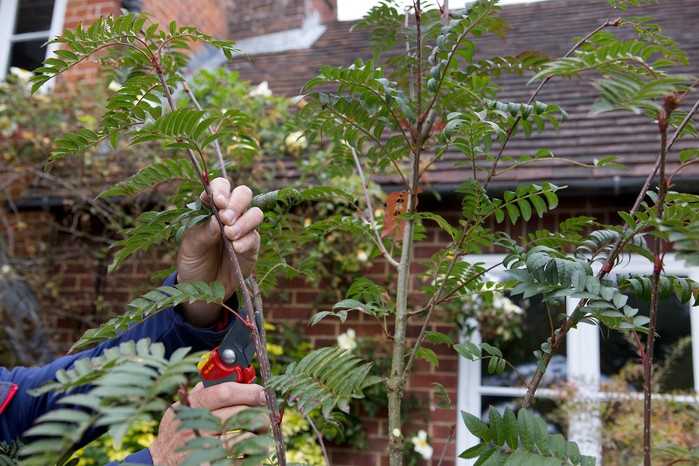- Tips for Successful Planting of Rowan Plants
- Choose the Right Location
- Prepare the Soil
- Planting Depth
- Watering
- Mulching
- Pruning
- Fertilizing
- Protecting from Pests and Diseases
- Cultivar Selection
- Enjoy the Benefits
- Choose the Right Location
- Prepare the Soil Properly
- Plant at the Right Time
- Provide Adequate Watering
- Use Fertilizers Wisely
- 1. Choose the Right Fertilizer
- 2. Follow the Instructions
- 3. Avoid Over-Fertilization
- 4. Apply Fertilizer at the Right Time
- 5. Use Slow-Release Fertilizers
- 6. Water the Plants Properly
- 7. Monitor the Plants
- 8. Consider Soil Testing
- Prune Regularly
- 1. Timing
- 2. Equipment
- 3. Remove Deadwood
- 4. Thin the Canopy
- 5. Shape the Tree
- 6. Avoid Over-Pruning
- 7. Dispose of Pruned Branches Properly
- Protect from Pests and Diseases
- 1. Regularly inspect your plants
- 2. Remove any infected or infested parts
- 3. Use organic pest control methods
- 4. Maintain a healthy growing environment
- 5. Practice crop rotation
- 6. Keep the surrounding area clean
- 7. Monitor and control pests and diseases
- 8. Seek professional help if needed
- Conclusion
- Seek Expert Advice
- Questions and Answers:
- What type of soil is best for planting rowan plants?
- When is the best time to plant rowan plants?
- How should rowan plants be watered after planting?
- Do rowan plants require full sun or partial shade?
- What is the recommended planting distance for rowan plants?
- How long does it take for rowan plants to bear fruit?
- Videos: How to plant a tree in a container | Grow at Home | RHS
Planting rowan plants can be a rewarding experience, but without proper care and attention, your efforts can be in vain. Whether you are a seasoned gardener or a beginner, these expert tips will help you achieve successful growth and a vibrant display of rowan plants in your garden.
First and foremost, it is crucial to choose the right location for your rowan plants. Rowan trees thrive in well-draining soil that is slightly acidic. They prefer full sun but can tolerate some shade. It is advisable to avoid planting them near buildings or other structures to allow for adequate airflow and prevent potential damage during storms.
Before planting, it is essential to prepare the soil properly. Dig a hole that is twice as wide and as deep as the root ball of your rowan plant. Loosen the soil at the bottom of the hole and mix in compost or well-rotted manure to improve drainage and provide nutrient-rich soil for the tree’s roots. This will create an optimal environment for the roots to establish and grow.
Once your rowan plant is in the ground, it is crucial to provide it with the right amount of water. While rowan trees are relatively drought tolerant, they still require regular watering, especially during the first year of growth. Water deeply and thoroughly, making sure to soak the soil around the roots. Avoid overwatering, as this can lead to root rot and other issues. A layer of mulch around the base of the tree will help conserve moisture and prevent weeds from competing for nutrients.
Tips for Successful Planting of Rowan Plants
Choose the Right Location
Rowan plants are adaptable and can grow in a variety of soil types, but they prefer well-draining soil. Choose a location that receives full sun or partial shade.
Prepare the Soil
Before planting your rowan plants, prepare the soil by removing any weeds or grass from the area. Loosen the soil with a garden fork or spade to a depth of about 12 inches. Add organic matter, such as compost or well-rotted manure, to improve the soil’s fertility and drainage.
Planting Depth
When planting rowan plants, dig a hole that is slightly larger than the root ball. Place the plant in the hole, making sure that the top of the root ball is level with or slightly above the soil surface. Backfill the hole with soil, firming it gently around the roots.
Watering
After planting, water your rowan plants thoroughly to help settle the soil and ensure good root growth. Water regularly, especially during dry periods, to keep the soil evenly moist but not waterlogged.
Mulching

Apply a layer of mulch around your rowan plants to help conserve moisture, suppress weeds, and regulate soil temperature. Use a natural mulch, such as wood chips or bark, and spread it about 2-3 inches deep around the base of the plants, keeping it away from the stems.
Pruning
Prune your rowan plants in late winter or early spring to remove any dead, damaged, or crossing branches. This will help promote air circulation and reduce the risk of disease. Avoid pruning heavily as rowan plants have a natural, attractive shape.
Fertilizing
Rowan plants generally do not require heavy fertilization. However, you can apply a balanced, slow-release fertilizer in the spring to provide some nutrients. Follow the manufacturer’s instructions for the proper amount to use.
Protecting from Pests and Diseases
Rowan plants are generally resistant to many pests and diseases. However, they can occasionally be attacked by aphids, caterpillars, or fungal diseases. Monitor your plants regularly and take appropriate measures if any issues arise.
Cultivar Selection
When choosing rowan plants for your garden, consider the cultivar’s mature size, flower color, and fruit characteristics. Some cultivars have larger fruits that attract birds, while others have colorful berries that add visual interest.
Enjoy the Benefits
Once your rowan plants are established, you can enjoy their beautiful flowers in spring, vibrant foliage in autumn, and attractive berries that persist into winter. They also provide habitat and food for birds and other wildlife, making them a valuable addition to any garden.
Choose the Right Location
When it comes to planting rowan plants, selecting the right location is crucial for their successful growth and development. Here are some important factors to consider:
- Sunlight: Rowan plants thrive in full sunlight. Make sure to choose a location that receives at least 6-8 hours of direct sunlight per day.
- Soil: Rowan plants prefer well-draining soil that is rich in organic matter. Avoid areas with heavy or compacted soil to prevent waterlogging and root rot.
Moisture: While rowan plants are relatively drought-tolerant, they still require regular watering, especially during their establishment period. Choose a location where the soil retains moisture without becoming waterlogged. - Protection: While rowan plants can tolerate a wide range of climates, it is best to choose a location that provides some protection from strong winds. This will help prevent damage to the branches and ensure the plant’s stability.
- Space: Consider the mature size of the rowan plant and ensure that there is enough space for it to grow and spread its branches without overcrowding other plants or structures.
By carefully selecting the right location for your rowan plants, you can provide them with the ideal conditions they need to thrive and enhance the beauty of your garden or landscape.
Prepare the Soil Properly
Properly preparing the soil before planting rowan plants is crucial for their successful growth and development. Here are some important steps to follow:
- Choose the right location: Select a location that receives full sun or partial shade for at least six hours a day. Rowan plants thrive in well-drained soil, so avoid areas with heavy clay or poorly drained soil.
- Test the soil: It’s essential to test the soil’s pH level before planting. Rowan plants prefer slightly acidic to neutral soil with a pH range of 5.5 to 7.0. Adjust the pH if necessary by adding lime to raise it or elemental sulfur to lower it.
- Clear the area: Remove any weeds, grass, rocks, or debris from the planting area. This will help prevent competition for nutrients and give the rowan plants a better start.
- Loosen the soil: Use a garden fork or tiller to loosen the soil to a depth of about 12 to 18 inches. This will improve soil drainage, aeration, and root penetration.
- Amend the soil: If the soil lacks organic matter, add compost or well-rotted manure to improve its fertility and structure. Work the amendments into the soil thoroughly.
- Level and smooth the soil: Rake the soil surface to create a smooth and level bed for planting the rowan plants. This will help with proper water distribution and prevent water pooling.
- Water the soil: Before planting, water the soil to ensure it is moist but not waterlogged. This will provide a favorable environment for the young rowan plants’ roots to establish themselves.
Following these steps will help set the stage for successful rowan plant growth. Remember to regularly water and mulch the plants after planting to keep the soil moist and suppress weed growth.
Plant at the Right Time
Choosing the right time to plant your rowan plants is crucial for their successful growth and development.
1. Consider the Season
Rowan plants are best planted in the late fall or early spring when the soil is moist and cool. Planting during these seasons allows the roots to establish themselves before the hot summer weather arrives.
2. Check the Frost Dates
Before planting, it is essential to check the average frost dates in your area. Rowan plants are hardy but can be damaged by late spring frosts. Planting after the last expected frost date ensures that the plants will not be harmed.
3. Soil Temperature
Another important factor to consider is the soil temperature. Rowan plants prefer to be planted when the soil temperature is around 50-55°F (10-13°C). This temperature range allows for optimal root growth.
4. Avoid Planting During Heatwaves
Avoid planting rowan plants during extreme heatwaves as this can cause stress to the plants and make it more difficult for them to establish. If you are experiencing a heatwave, it is best to wait until the weather cools down before planting.
5. Watering Considerations
When planting rowan plants, it is important to ensure that they receive adequate water, especially during the establishment period. Planting during a time when rainfall is more frequent can help reduce the need for supplemental watering.
By following these guidelines and planting at the right time, you increase the chances of success and ensure that your rowan plants thrive in their new environment.
Provide Adequate Watering
Watering is a crucial aspect of successful rowan plant growth. Proper watering ensures that the plants receive adequate hydration to support their growth and development. Here are some tips to provide adequate watering:
- Establish a watering schedule: Create a regular watering schedule to ensure that the plants receive consistent moisture. This is especially important during the initial growth period.
- Water deeply: When watering rowan plants, it is important to provide deep watering rather than surface-level moisture. Deep watering encourages the roots to grow deeper and helps the plants become more resilient.
- Check soil moisture: Regularly check the moisture level of the soil to determine if watering is necessary. You can do this by inserting your finger into the soil up to the second knuckle. If it feels dry at that depth, it’s time to water.
- Use the right amount of water: It is important to avoid overwatering or underwatering rowan plants. Provide enough water to moisten the soil thoroughly without saturating it. A good rule of thumb is to provide one inch of water per week.
- Water at the right time: Watering in the morning or evening is ideal as it allows the plants to absorb the moisture before the heat of the day evaporates it. Avoid watering during the hottest part of the day.
By following these watering tips, you can ensure that your rowan plants receive the right amount of hydration for healthy growth and development.
Use Fertilizers Wisely
Fertilizers can greatly benefit the growth and health of your rowan plants. However, it is important to use them wisely to avoid over-fertilization and potential harm to the plants. Here are some tips:
1. Choose the Right Fertilizer
There are different types of fertilizers available, such as organic and synthetic options. Consider the specific needs of your rowan plants and choose a fertilizer that provides the necessary nutrients.
2. Follow the Instructions
Always read and follow the instructions provided by the manufacturer. The instructions will provide guidance on the appropriate amount of fertilizer to use and how often to apply it.
3. Avoid Over-Fertilization
It is important not to over-fertilize your rowan plants as it can lead to nutrient imbalances and damage the roots. Follow the recommended dosage and avoid applying excessive amounts of fertilizer.
4. Apply Fertilizer at the Right Time
Timing is crucial when it comes to fertilizing rowan plants. Apply the fertilizer during the appropriate season, usually in early spring or late fall, when the plants are actively growing.
5. Use Slow-Release Fertilizers
Consider using slow-release fertilizers that release nutrients gradually over time. This will provide a steady supply of nutrients to the plants and reduce the risk of over-fertilization.
6. Water the Plants Properly
After applying fertilizer, make sure to water the plants thoroughly. This will help the nutrients in the fertilizer to penetrate the soil and reach the roots effectively.
7. Monitor the Plants
Keep an eye on the condition of your rowan plants. If you notice any signs of nutrient deficiencies or over-fertilization, adjust the fertilizer application accordingly.
8. Consider Soil Testing
To ensure that your rowan plants are receiving the necessary nutrients, consider conducting a soil test. This will help you determine any nutrient deficiencies or imbalances in the soil and allow you to adjust the fertilizer application accordingly.
By following these tips, you can ensure that your rowan plants receive the right amount of nutrients from fertilizers, promoting their growth and overall health.
Prune Regularly
Regular pruning is essential for the healthy growth and maintenance of rowan plants. Pruning helps to shape the tree, promote air circulation, and remove dead or diseased branches. Here are some tips for successful pruning of rowan plants:
1. Timing

Prune rowan plants in late winter or early spring, before new growth begins. This allows the tree to heal quickly and minimizes the risk of disease or insect infestation.
2. Equipment
Use sharp, clean pruning shears or saws to make precise cuts. This prevents tearing and promotes faster healing.
3. Remove Deadwood
Start by removing any dead or diseased branches. These can attract pests and diseases, impacting the overall health of the tree. Cut back to healthy wood, making a clean cut just above the branch collar.
4. Thin the Canopy

To improve air circulation and reduce the risk of diseases, thin out the canopy by removing some of the interior branches. This helps sunlight reach the lower parts of the tree and promotes overall health.
5. Shape the Tree
Pruning can help shape rowan plants into desired forms, such as multi-stemmed shrubs or single-trunked trees. Carefully remove any branches that are growing in unwanted directions to achieve the desired shape.
6. Avoid Over-Pruning
Avoid over-pruning or removing too much of the tree’s canopy, as this can stress the plant and weaken its overall health. Aim to maintain a natural and balanced shape.
7. Dispose of Pruned Branches Properly
Properly dispose of pruned branches to prevent the spread of diseases or pests. Cut them into small pieces and dispose of them in sealed bags, or use them for mulch or composting.
By regularly pruning your rowan plants, you can promote their health and vitality, ensuring they thrive in your garden or landscape. Follow these tips for successful pruning and enjoy the benefits of a well-maintained rowan plant.
Protect from Pests and Diseases

Rowan plants are generally resistant to most pests and diseases. However, it is still important to take precautions to protect them from potential threats. Here are some tips to help you keep your rowan plants healthy and free from pests and diseases:
1. Regularly inspect your plants
Take the time to inspect your rowan plants regularly for any signs of pests or diseases. Look for any discoloration, spots, holes, or other abnormalities on the leaves, branches, and trunk. Early detection is key to preventing the spread of pests and diseases.
2. Remove any infected or infested parts
If you notice any infected or infested parts on your rowan plants, such as diseased leaves or branches with pests, it is important to remove them immediately. Prune off the affected parts and dispose of them properly to prevent further spread.
3. Use organic pest control methods
Consider using organic pest control methods to protect your rowan plants. This may include using insecticidal soaps, neem oil, or other natural remedies that are safe for the environment and won’t harm beneficial insects.
4. Maintain a healthy growing environment
Healthy plants are less prone to pests and diseases. Make sure your rowan plants are growing in the right conditions, with adequate sunlight, water, and nutrients. Avoid excess moisture, as this can attract pests and promote disease development.
5. Practice crop rotation
If you are planting rowan plants in the same area each year, consider practicing crop rotation. This involves planting different crops or plants in a different location each year to disrupt pest and disease cycles.
6. Keep the surrounding area clean
Remove any debris or fallen leaves around your rowan plants regularly. Pests and diseases can hide and overwinter in these materials, so keeping the area clean can help prevent infestations and infections.
7. Monitor and control pests and diseases
If you do notice any pests or diseases on your rowan plants, take immediate action to control them. This may involve applying natural or chemical treatments specifically designed for the pest or disease in question. Consult with a local gardening expert for the best course of action.
8. Seek professional help if needed
If you are unsure about how to handle a pest or disease problem with your rowan plants, don’t hesitate to seek professional help. A trained horticulturist or arborist can provide valuable advice and assistance in protecting your plants.
Conclusion
With proper care and attention, you can protect your rowan plants from pests and diseases and ensure their successful growth. Regular inspection, prompt action, and the use of organic methods can help you maintain a healthy and vibrant rowan plant.
Seek Expert Advice
When it comes to planting rowan plants, seeking expert advice can be extremely beneficial. Experts have years of experience and knowledge in the field and can provide valuable guidance to ensure successful plantation.
Here are some reasons why seeking expert advice is important:
- Variety Selection: Experts can suggest the most suitable variety of rowan plants for your specific location and soil conditions. They can guide you on which variety will thrive best in your climate and meet your requirements.
- Planting Techniques: Experts can provide detailed information on the correct planting techniques for rowan plants. This includes the ideal time of the year to plant, proper depth for planting, and spacing between plants.
- Soil Preparation: Experts can advise on the necessary soil preparation before planting rowan plants. They can guide you on how to improve soil quality, amend it with organic matter, and ensure proper drainage.
- Watering and Fertilization: Experts can explain the proper watering and fertilization requirements for rowan plants. They can suggest the best watering schedule, as well as the appropriate type and amount of fertilizer to use.
- Pest and Disease Control: Experts can educate you on common pests and diseases that affect rowan plants and provide preventive measures to protect your plants. They can also recommend organic or chemical control methods if necessary.
Remember that seeking expert advice doesn’t necessarily mean hiring a professional. You can also consult local gardening centers, nurseries, or online forums where experienced gardeners are willing to share their knowledge and provide guidance.
By seeking expert advice, you can enhance your chances of successfully planting rowan plants and enjoy a thriving and beautiful garden.
Questions and Answers:
What type of soil is best for planting rowan plants?
The best type of soil for planting rowan plants is well-draining soil that is rich in organic matter.
When is the best time to plant rowan plants?
The best time to plant rowan plants is in the early spring or late fall, when the weather is cooler.
How should rowan plants be watered after planting?
Rowan plants should be watered deeply and regularly after planting, especially during dry periods.
Do rowan plants require full sun or partial shade?
Rowan plants prefer full sun, but they can tolerate partial shade as well.
What is the recommended planting distance for rowan plants?
The recommended planting distance for rowan plants is 10 to 15 feet apart, depending on the variety.
How long does it take for rowan plants to bear fruit?
Rowan plants usually start bearing fruit in 2 to 3 years after planting.







